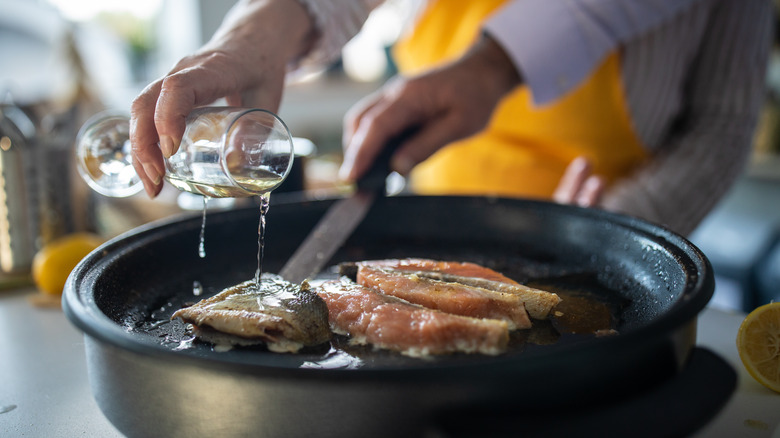How To Fix An Overly Heavy Pour Of Sparkling Wine In Almost Any Dish
In the spirit of not wasting, we've recommended cooking as a way to use leftover champagne. But what happens when you try your hand at our champagne chicken recipe and miscalculate your pour? Now there's too much wine in your dish! The answer is not to toss your meal in the garbage. Rather, maintain the anti-waste spirit and rectify your chicken with this wine tip for fixing an overly "winey" dish: Simply add fat.
Since sparkling wines are sweeter, their sugariness intensifies when they cook down. When you add a fat such as butter to the dish, its richness neutralizes sparkling wine's sweetness and balances out the flavors. But say your dish already has butter as its base, you can still use spices to balance out the sweetness. Think peppercorn, bay leaves, or cayenne to steer your dish in another direction.
Sparkling wines are also highly acidic, so their sharp, bitter flavor simultaneously enhances as they reduce. Again, fat comes to the rescue by cutting through wine's acidity with richness. Adding olive oil or butter is Alex Guarnaschelli's tip for fixing a dish after you add too much wine, which she shared with Food & Wine. It seems fat is the perfect add-in since it soaks up flavors and alters the texture of food by giving it a smoother mouthfeel thereby making it more pleasant to taste.
The science of fat for flavoring
You've probably noticed how adding too much fat to a dish requires you to season it plenty — that's because fat tends to mask flavors. When attempting to save your sparkling wine dish, you're "reverse-applying" this method, and instead of seasoning more, you're adding more fat and allowing it to cover up the excessively sweet or acidic wine flavors. As a bonus, fat such as heavy cream enriches the dish with creamy flavors.
As for adding spices to a butter-based dish, you're relying on fat's flavor-carrying property to work its magic and transform your dish with added flavors. Instead of counting on more fat to mask the sweetness, you rely on it to add another dimension to the dish. Do it right and you should get a fragrant, spice-forward dish of balanced flavors.
If, perhaps, you're counting calories and want to limit the amount of fat in your diet, it's not the end of the world for your dish. You can add in an alliaceous puree of onions, garlic, and herbs to do a similar job at a fraction of the calories. And if balancing the flavors proves ineffective, don't beat yourself up about pouring too much wine in the first place — it's only one of the mistakes everyone makes when cooking with wine. Go back to the frying pan and try doubling the recipe to dilute the intense flavor before giving up and discarding the dish completely.

